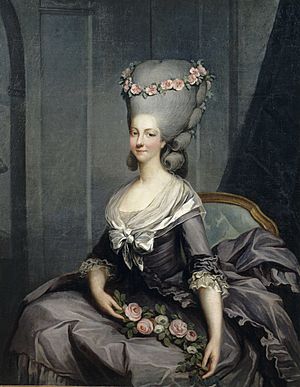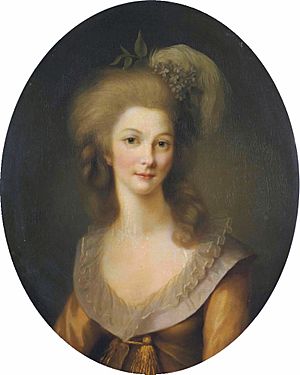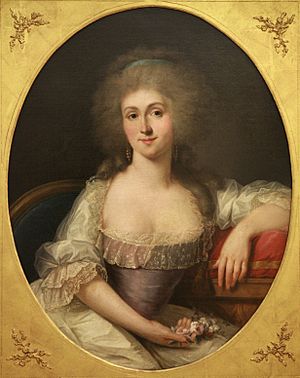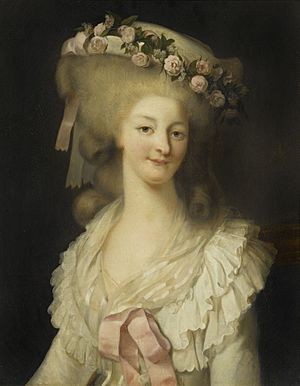Marie Thérèse Louise of Savoy, Princesse de Lamballe facts for kids
Quick facts for kids Marie Thérèse Louise of Savoy |
|||||
|---|---|---|---|---|---|
| Princess of Lamballe | |||||

Portrait by Antoine-François Callet, 1776
|
|||||
| Born | 8 September 1749 Palazzo Carignano, Turin, Savoy |
||||
| Died | 3 September 1792 (aged 42) Paris, France |
||||
| Spouse | |||||
|
|||||
| House | Savoy-Carignano | ||||
| Father | Louis Victor of Savoy, Prince of Carignano | ||||
| Mother | Princess Christine of Hesse-Rotenburg | ||||
| Religion | Roman Catholicism | ||||
| Signature | |||||
Marie Thérèse Louise (born Maria Teresa Luisa; 8 September 1749 – 3 September 1792) was a princess from the House of Savoy-Carignano. This was a branch of the royal House of Savoy in Italy. When she was 17, she married Louis Alexandre de Bourbon-Penthièvre, who was the Prince of Lamballe. He was the heir to one of the largest fortunes in France.
After her marriage, which lasted only a year, she went to the French royal court. There, she became a close friend and trusted helper of Queen Marie Antoinette. Marie Thérèse Louise was tragically killed during the September Massacres in 1792, a violent time during the French Revolution.
Contents
Early Life
Maria Teresa Luisa was born on 8 September 1749 in Palazzo Carignano in Turin, Italy. She was the sixth child of Louis Victor, Prince of Carignano. Her mother was Princess Christine of Hesse-Rotenburg. People were very happy when she was born, cheering and singing in the streets. We don't know much about her early childhood.
Marriage and Widowhood
On 31 January 1767, Maria Teresa married Louis Alexandre de Bourbon-Penthièvre. This was a "proxy marriage," meaning someone stood in for the groom during the ceremony. Louis Alexandre was the grandson of Louis XIV's son, Louis Alexandre de Bourbon.
The marriage was suggested by Louis XV, the King of France. Both Marie Thérèse and Louis Alexandre came from royal families, so it was seen as a good match. Her family agreed because the King of Sardinia wanted a connection between the House of Savoy and the House of Bourbon.
The wedding ceremony was held in Turin, Italy. Afterward, she traveled to France. She was introduced to the French royal court at the Palace of Versailles in February. Everyone was impressed by her. In France, she started using the French version of her name, Marie Thérèse Louise.
At first, their marriage seemed very happy. But after only a few months, Louis Alexandre was unfaithful. This made Marie Thérèse very sad. Her father-in-law, the Duke of Penthièvre, comforted her, and they became very close.
In 1768, when she was just 19, Marie Thérèse became a widow. Her husband died after only one year of marriage. Marie Thérèse inherited a large fortune from him, making her very wealthy. Her father-in-law convinced her not to become a nun. Instead, she stayed with him. She helped him with his many charity projects. Because of their kindness, he was called "King of the Poor," and she was known as "The Angel of Penthièvre."
Royal Lady-in-Waiting

Marie Thérèse had an important role in royal events. When Marie Antoinette arrived in France in 1770 to become the new Dauphine (future queen), Marie Thérèse was presented to her. Marie Antoinette was charmed by Marie Thérèse and gave her a lot of attention. People at court noticed how close they became.
On 18 September 1775, after Marie Antoinette's husband became King Louis XVI, Marie Antoinette gave Marie Thérèse a very important job. She became the "Superintendent of the Queen's Household." This was the highest position for a lady-in-waiting at Versailles. This job was controversial because it was expensive and gave a lot of power. Marie Thérèse was also considered too young for such a high role. However, the Queen saw it as a reward for her friend.
The Empress Maria Theresa, Marie Antoinette's mother, worried about this friendship. She feared Marie Thérèse might try to help her home country, Savoy, through the Queen. But Marie Antoinette told her husband, "Ah, sire, the Princesse de Lamballe's friendship is the charm of my life." Marie Thérèse even helped her brother get a good position in the French army and her brother-in-law get a governorship, thanks to the Queen.
Marie Thérèse was described as proud and sensitive. She was not known for being witty or for getting involved in plots. She enjoyed spending time alone with the Queen. She often suffered from "nerves" and would sometimes faint. Her job as Superintendent meant she had to approve all orders for the Queen. She also had to host events for the Queen. This job made many people at court jealous. It also came with a huge salary. Because of France's financial problems, she was asked to give up the salary. When she refused, she was granted the money by the Queen. This caused bad publicity, making people think she was a greedy favorite. Her fainting spells were also mocked.
Around 1775, Marie Thérèse was slowly replaced as the Queen's closest friend by Yolande de Polastron, the Duchesse de Polignac. Yolande was more outgoing and social, while Marie Thérèse was more reserved. Marie Antoinette started to prefer Yolande's company. Even though Marie Thérèse was no longer the Queen's main favorite, their friendship continued. Marie Antoinette still visited her and valued her loyalty. She once said, "She is the only woman I know who never bears a grudge; neither hatred nor jealousy is to be found in her."
Marie Thérèse kept her important job as Superintendent and continued her duties. She hosted balls, introduced new people to the Queen, and attended royal ceremonies. She also became interested in Freemasonry. She joined a women's Freemason lodge in 1777 and became its Grand Mistress in 1781.
Marie Thérèse often had poor health. In the mid-1780s, her health got worse, making it hard for her to do her duties. She even traveled to England in 1787 to try a special water treatment for her health. After this trip, her health improved, and she became more active at court. The Queen showed her more affection again, especially as her friendship with Yolande de Polignac became strained.
In the spring of 1789, Marie Thérèse was at Versailles for the opening of the Estates General of 1789, a big meeting that led to the French Revolution.
During the French Revolution
When the Storming of the Bastille happened in July 1789, starting the French Revolution, Marie Thérèse was in Switzerland. When she returned to France in September, she stayed with her father-in-law. So, she was not at court during the Women's March on Versailles in October 1789.
On 7 October 1789, she learned about the Revolution's events. She immediately joined the royal family at the Tuileries Palace in Paris. There, she continued her duties as Superintendent. She lived in an apartment next to the Queen's. She was always by the Queen's side, both in public and private. She went with the royal family to St. Cloud in 1790 and attended the Fête de la Fédération in Paris.
Marie Thérèse began hosting many gatherings in her apartment at the Tuileries Palace. She hoped to bring together loyal nobles to support the Queen. Her gatherings became a place where the Queen met with members of the National Assembly. The Queen wanted to win them over to support the monarchy.
Marie Thérèse also checked the loyalty of the palace staff. She used a network of people to gather information. She would interview staff members to make sure they were loyal to the royal family.
After many of the Queen's close friends left France, Marie Antoinette warned Marie Thérèse that she would become a target of public anger. Negative writings, called libels, were spreading in Paris and would slander her. Marie Thérèse read some of these writings and knew about the hostility against her.
Marie Thérèse was not told about the Flight to Varennes beforehand. This was when the royal family tried to escape Paris in June 1791. The night they left, the Queen told her to go to the countryside for her health. The next day, Marie Thérèse received a note from Marie Antoinette telling her about the escape and asking her to meet in Brussels. Marie Thérèse immediately left France for England and then the Austrian Netherlands.
She wondered if she should return to France. Her friends told her to go back to the Queen, but her relatives wanted her to return to Italy. Marie Antoinette also wrote to her, asking her not to return. However, in October 1791, the Queen officially asked her to return to her duties or resign. Marie Thérèse felt it was her duty to return. She said, "I must live and die with her."
She wrote her will because she believed she was in danger if she returned to Paris. She arrived back in Paris on 4 November. Back at the Tuileries Palace, Marie Thérèse continued her work. She tried to gather supporters for the Queen and wrote to nobles who had left France, asking them to return.
During the Demonstration of 20 June 1792, a mob broke into the palace. Marie Thérèse was with the Queen. When the Queen wanted to go to the King, Marie Thérèse cried, "No, no, Madame, your place is with your children!" A table was placed in front of them to protect them. Marie Thérèse stood by the Queen's chair, supporting her for hours as the mob passed by. She showed great courage, focusing only on the Queen's safety.
Marie Thérèse continued to serve the Queen until the attack on the palace on 10 August 1792. She and the royal children's governess, Louise-Élisabeth de Croÿ de Tourzel, went with the royal family to seek safety in the Legislative Assembly. Marie Thérèse became ill there but insisted on returning to the family. She accompanied them to the Feuillant convent and then to the Temple prison.
Imprisonment and Death
On 19 August 1792, Marie Thérèse, Louise-Élisabeth de Croÿ de Tourzel, and her daughter Pauline were separated from the royal family. They were taken to the La Force prison. They were allowed to share a cell.
During the September Massacres, angry mobs attacked the prisons. Prisoners were quickly judged by makeshift courts. On 3 September 1792, Marie Thérèse was brought before one of these courts. She was asked to "take an oath to love liberty and equality and to swear hatred to the King and the Queen and to the monarchy." She agreed to swear to liberty but refused to speak against the King, Queen, and monarchy.
Her trial ended quickly. She was asked: "Who are you?" "Marie Thérèse Louise, Princess of Savoy." "Your job?" "Superintendent of the Household to the Queen." "Did you know about any plots on August 10th?" "I don't know if there were any plots on August 10th; but I know that I had no knowledge of them." "Swear to Liberty and Equality, and hatred of the King and Queen." "Readily to the first; but I cannot to the latter: it is not in my heart." Some people tried to whisper to her to take the oath to save her life. She then added: "I have nothing more to say; it is indifferent to me if I die a little earlier or later; I have made the sacrifice of my life." The court then said, "Let Madame be set at liberty."
She was then led outside to where the massacre was happening. She was struck and killed by the crowd.
In Media
The Princesse de Lamballe has been shown in several films and TV shows.
- Anita Louise played her in the 1938 film Marie Antoinette.
- Mary Nighy played her in the 2006 film Marie Antoinette.
Images for kids
See also
 In Spanish: María Teresa de Saboya-Carignano para niños
In Spanish: María Teresa de Saboya-Carignano para niños




